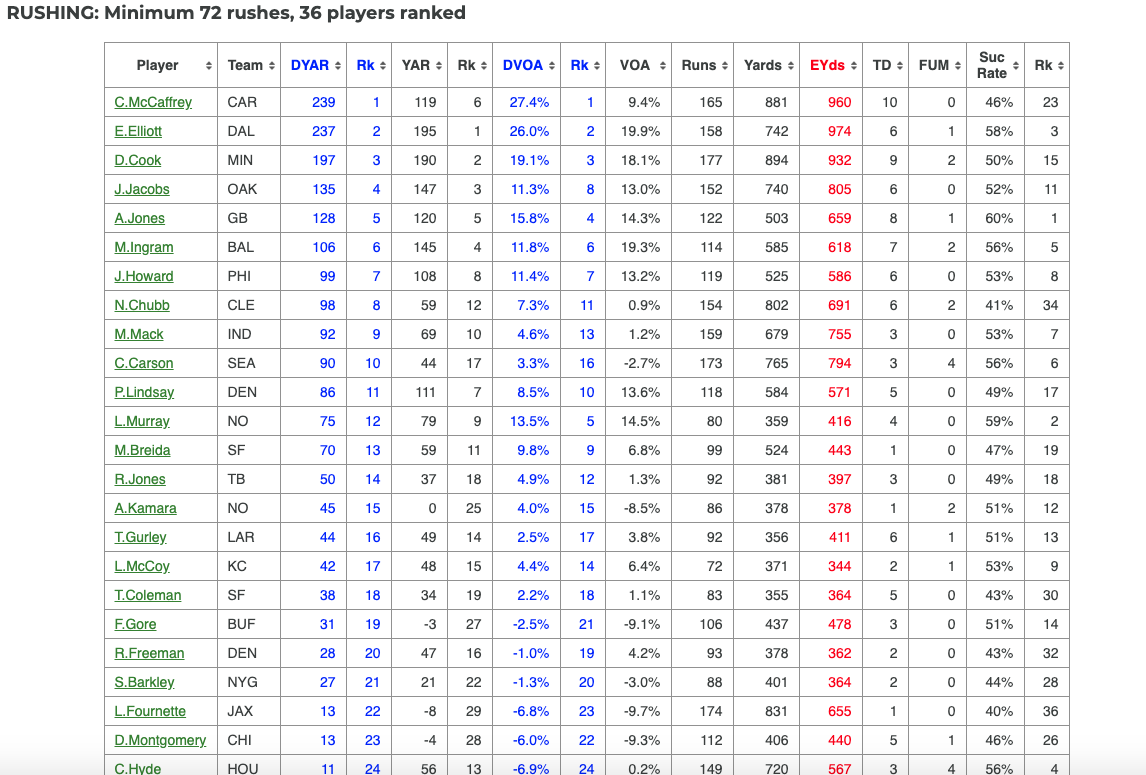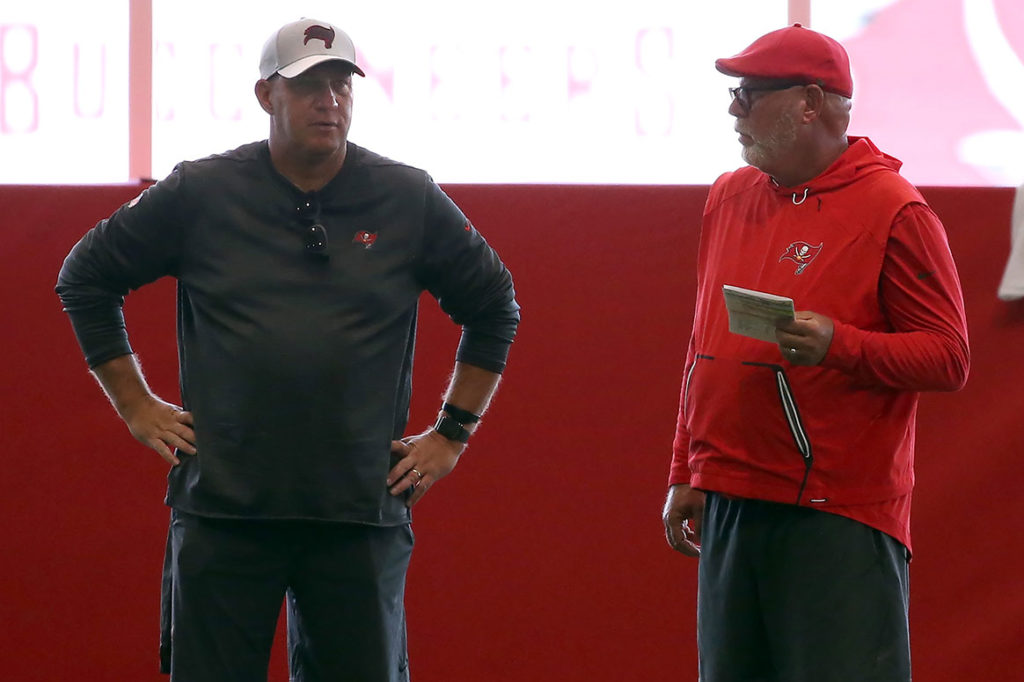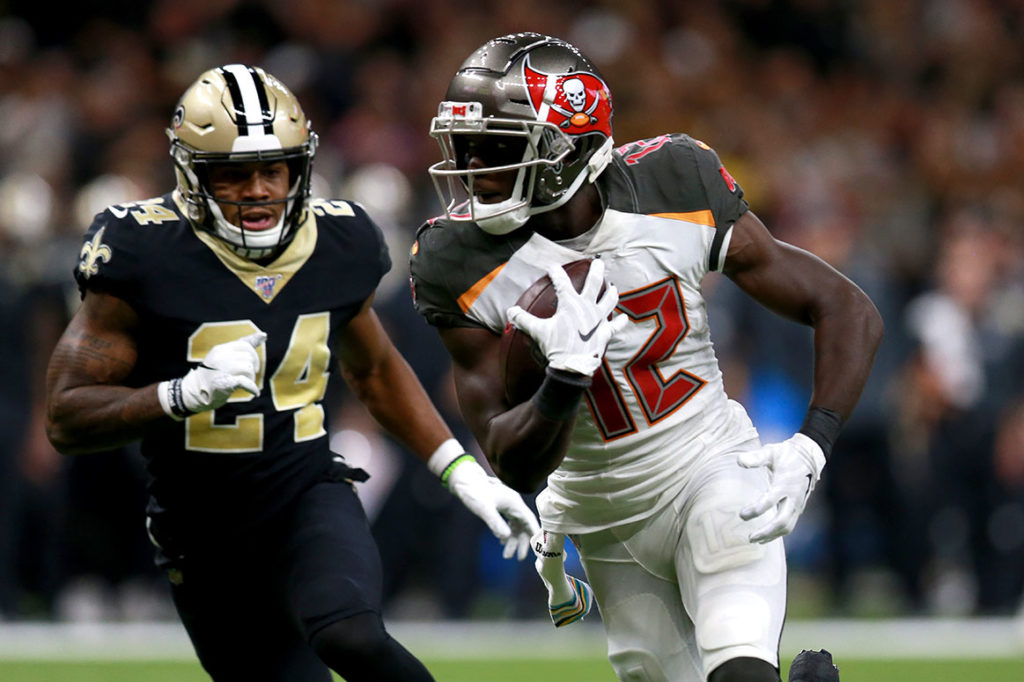Cover 3 is a weekly feature column written by PewterReport.com’s Tampa Bay Bucs beat writer Trevor Sikkema published every Tuesday. The column, as its name suggests, comes in three phases: a statistical observation, an in-depth film breakdown, and a “this or that” segment where the writer asks the reader to chose between two options.
Sikkema’s Stat of the Week
As we are a little over midway through the NFL season, I wanted to check in on some of the stats for the Buccaneers players to see how they are doing overall, how the team is choosing to use them, and whether or not it fits with how effective they have been in 2019.
Rather than just quoting to you the typical stats that you see every week such as passing yards or yards-per-attempt or receiving touchdowns, what I wanted to do is give you a little bit more context into the performances of your Buccaneers, not only versus the rest of the league but in a way that judges whether or not they are worth giving the ball to.
The best way I know how to do that is by looking at DVOA, a stat by Football Outsiders which stands for Defense-adjusted Value Over Average, which basically means, how much better is the subject player you are observing than what would be considered league average for a starter at such a position.
Not all rushes or catches or throws are the same. For example, a three-yard run on first-and-10 is not the same as a three-yard run on third-and-2. They’re the same net yards, but one is a success while the other is not as impactful. Each has different value in terms of measurable success that goes beyond just listing how many net yards were gained. It’s about the context of those yards. DVOA takes into account down and distance, in-game situations and whether or not a play accomplished, failed or even went above and beyond depending within its context, not just net yards gained. Each play is given a value depending on its level of success given the outcome in the situation; that gives us a measurable number; that gives us DVOA.
Along with DVOA, there is a stat metric called DYAR, which stands for Defense-adjusted Yards Above Replacement, which is essentially football’s version of the WAR (Win Above Replacement) stat in baseball. How many yards is such a player gaining above what would be a replacement level player at the position? The folks at FO explain DYAR by saying, if a running back has 300 carries in a season, and you take those away, where do they go? If you were to take the 300 touches one player got and disperse them elsewhere, would it be better or worse for the team? Is their value with the ball better than the ball being in the hands of someone else? Is their value higher or lower if they were to be replaced?
Let’s take a look at the quarterback position first.
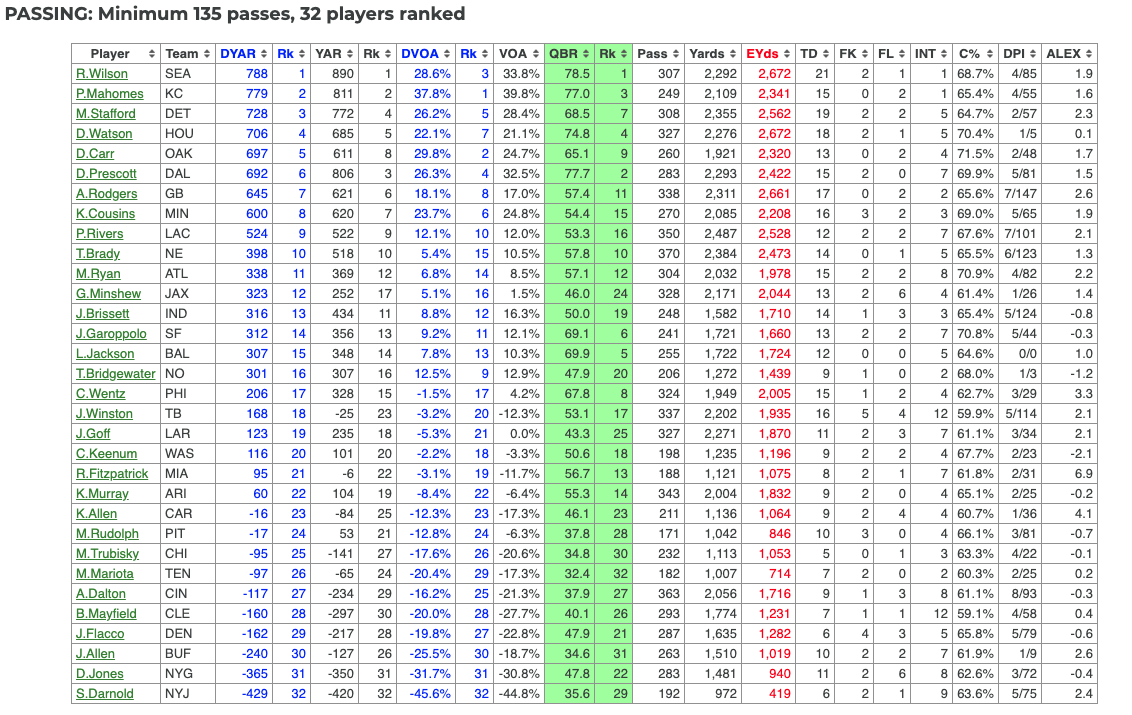 When it comes to DVOA, Jameis Winston’s value per play is lower than what would be considered the league average. His -3.2% DVOA means that given the context of situations including strength of defense he is playing and situational football for each play, Winston yielded slightly less than average results.
When it comes to DVOA, Jameis Winston’s value per play is lower than what would be considered the league average. His -3.2% DVOA means that given the context of situations including strength of defense he is playing and situational football for each play, Winston yielded slightly less than average results.
DVOA also takes into account turnovers, and doesn’t just have a set value for them. It’s not as if all fumbles are -2.0% or all interceptions are -3.0%. Each turnover also has context with it, and depending how much the turnover was due to the defense or due to the quarterback, that’s how the penalty is applied.
When you look at DVOA, DYAR and QBR, Winston was below the league average nine weeks into the season.
Moving on to the running back position, remember when Bucs fans were clamoring for this team to give Ronald Jones II the ball more? Well, turns out there was something to that, and it wasn’t just them watching games live and being biased in the moment.
Of players with at least 72 carries, Ronald Jones ranks 12th in DOVA and 14th in DYAR. That’s currently better than guys like New Orleans’ Alvin Kamara, New York’s Saquon Barkley and Jacksonville’s Leonard Fournette. Now, am I saying that Jones is a better running back than all those guys? No, certainly not right now. But what I am saying is that Jones clearly gives this team the best chance to be the most effective on the ground.
If you look at Peyton Barber’s rank (not listed because he is lower on the list), his DOVA is ranked 29th and his DYAR is ranked 30th. In fact, Barber has a DYAR score in the negatives at -25, which means that by giving Barber the ball, you are actually less effective than judged against a replacement level player at his position. Just like we shouldn’t swing too far in one direction for praising Jones here, Barber can have value, but on a play-by-play basis, the potential for a positive outcome when the ball is in Jones’ hands is much greater than when it is Barbers’.
Jones should out-touch Barber by quite a bit the rest of this season.
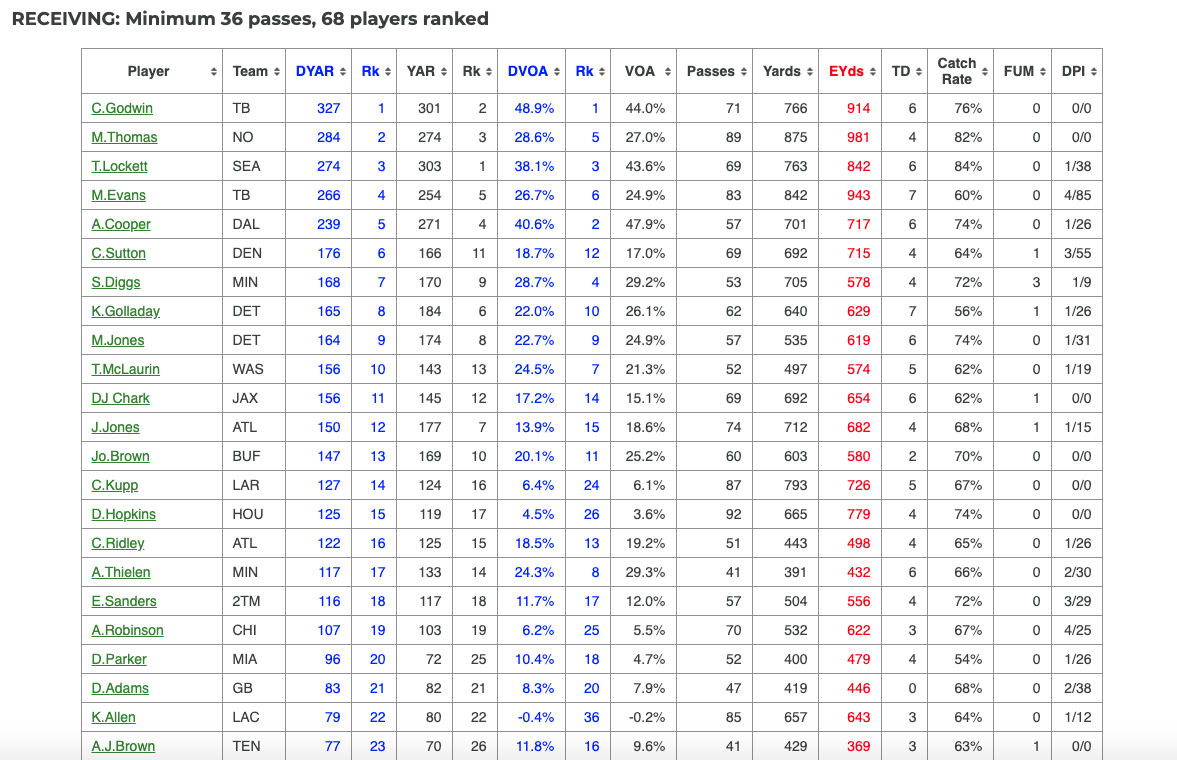 As if you needed advanced statistics to tell you this, the Bucs’ top two wide receivers of Chris Godwin and Mike Evans are really freaking good.
As if you needed advanced statistics to tell you this, the Bucs’ top two wide receivers of Chris Godwin and Mike Evans are really freaking good.
Through nine weeks of the season, Godwin is far and away ranked No. 1 in both DVOA and DYAR. As for Evans, he’s No 6 in DVOA and No. 4 in DYAR.
Evans and Godwin are both in the Top 10 in the NFL in terms of targets with 89 for Evans and 83 for Godwin. When you look at the DYAR stat, the one that measure how many yards they accumulate over what would be a replacement level player, that conformed that feeding both of these guys has a pay off well worth the emphasis in the game plan.
As for the Bucs other receiver, Scotty Miller and Breshad Perriman, their DVOA and DYAR scores are much, much lower. Miller has a DVOA of -68.2%, which is one of the lowest in the league, and has a DYAR of -47 yards. Perriman’s is even worse with a DVOA of -53.0% and -74 yards. When the ball goes to these guys, it’s often not worth the look.
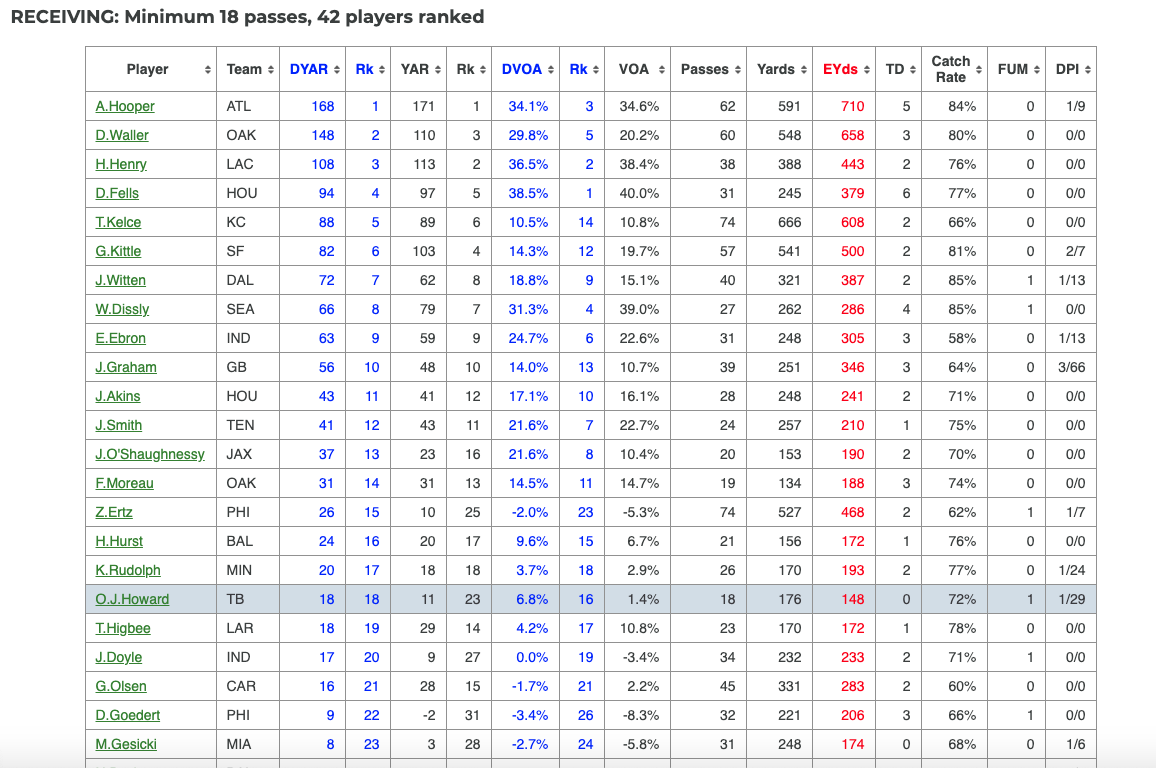 Finally let’s look at the tight end position. The benefits for the Bucs throwing the ball to their tight ends this year aren’t as drastically positive as they are for their wide receivers, but both O.J. Howard and Cam Brate have recorded positive DYAR scores halfway through the season.
Finally let’s look at the tight end position. The benefits for the Bucs throwing the ball to their tight ends this year aren’t as drastically positive as they are for their wide receivers, but both O.J. Howard and Cam Brate have recorded positive DYAR scores halfway through the season.
Howard’s yards above replacement come out to 18 and Brate’s is right at eight. However, I will say, in Howard’s case, usage plays a role here, as Howard was Top 5 in DVOA the past two seasons, including No. 1 in the NFL last year. Howard is having a shaky third season for a number of different reasons, but the potential for positive adjusted scoring is certainly there for him.
So, after looking at the DVOA and DYAR scores midway through the season (big shoutout again to the guys over at Football Outsiders) my main takeaways are: it’s RoJo’s show, feed Godwin and Evans no matter what, this team really needs a better WR3, and O.J. Howard need more looks.
We dive into some film on all that on the next page.
Trevor Sikkema is the Tampa Bay Buccaneers beat reporter and NFL Draft analyst for PewterReport.com. Sikkema, an alumnus of the University of Florida, has covered both college and professional football for much of his career. As a native of the Sunshine State, when he's not buried in social media, Sikkema can be found out and active, attempting to be the best athlete he never was. Sikkema can be reached at: [email protected]

